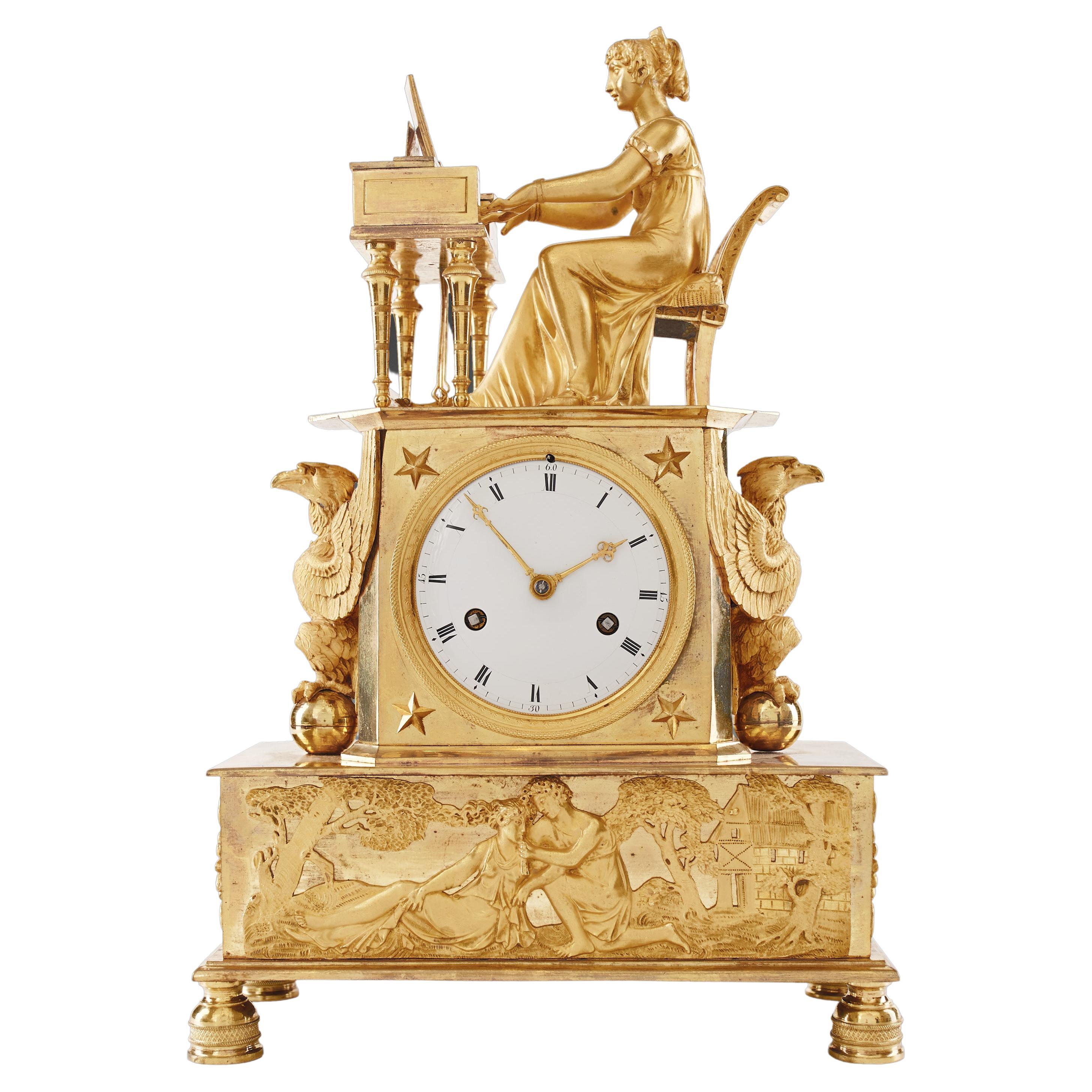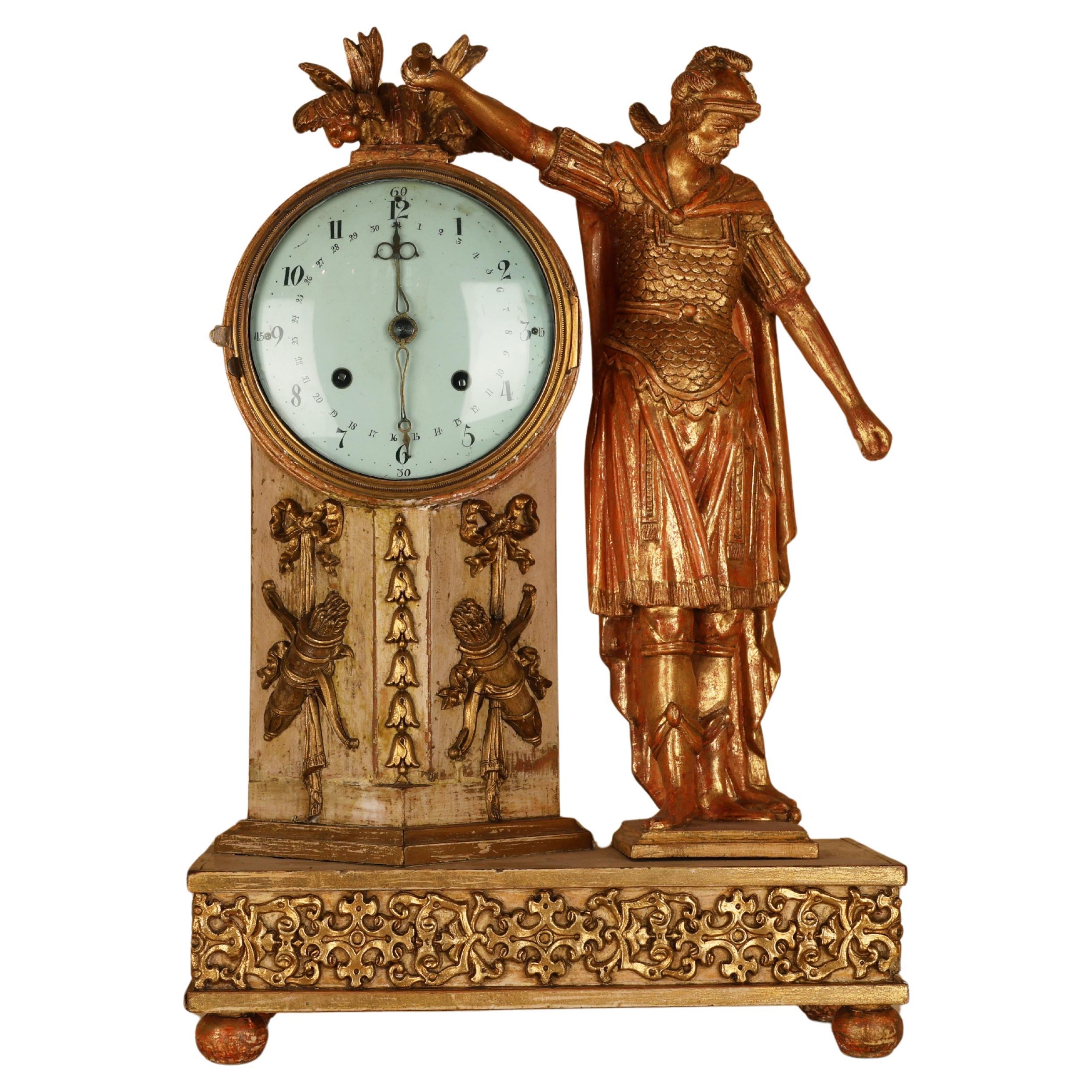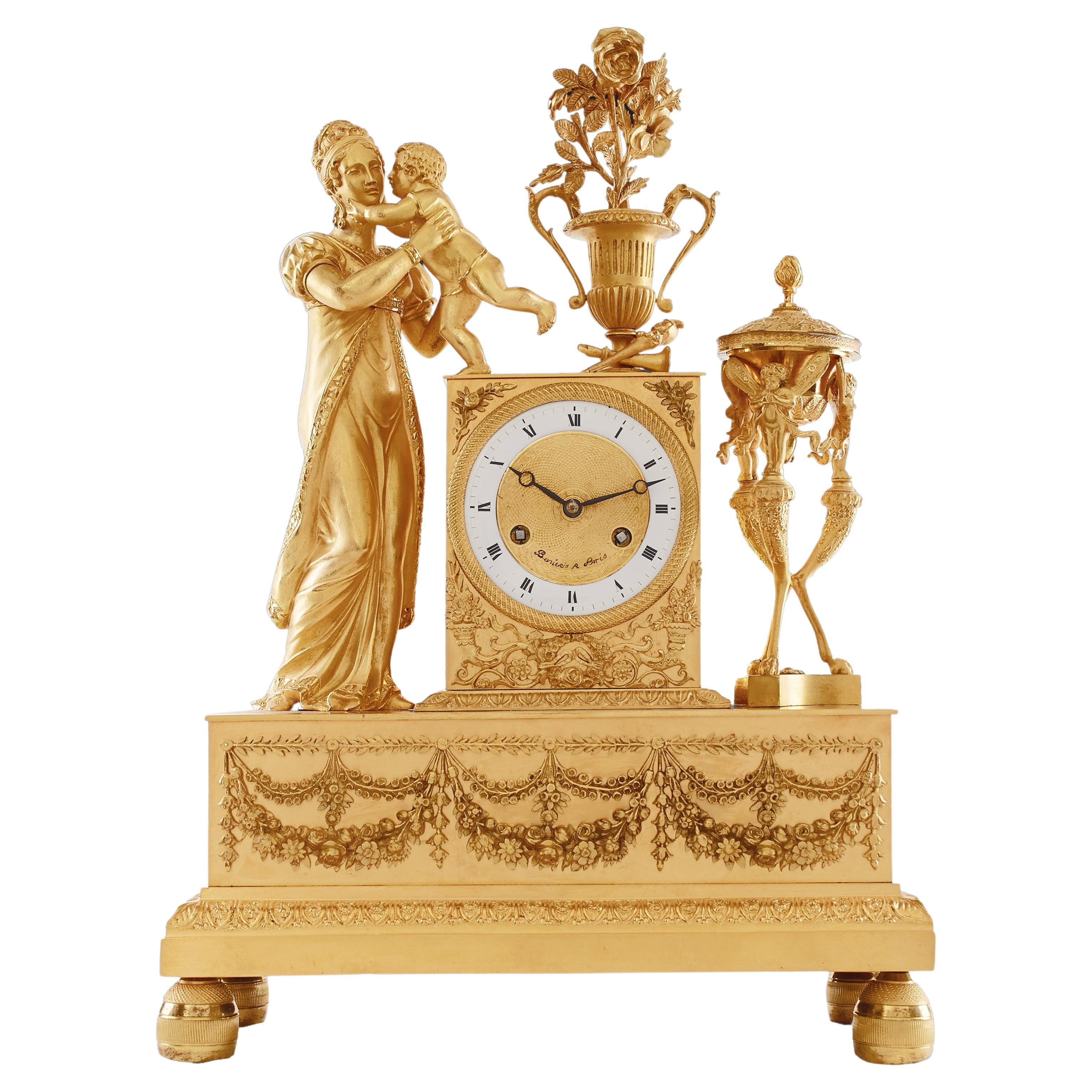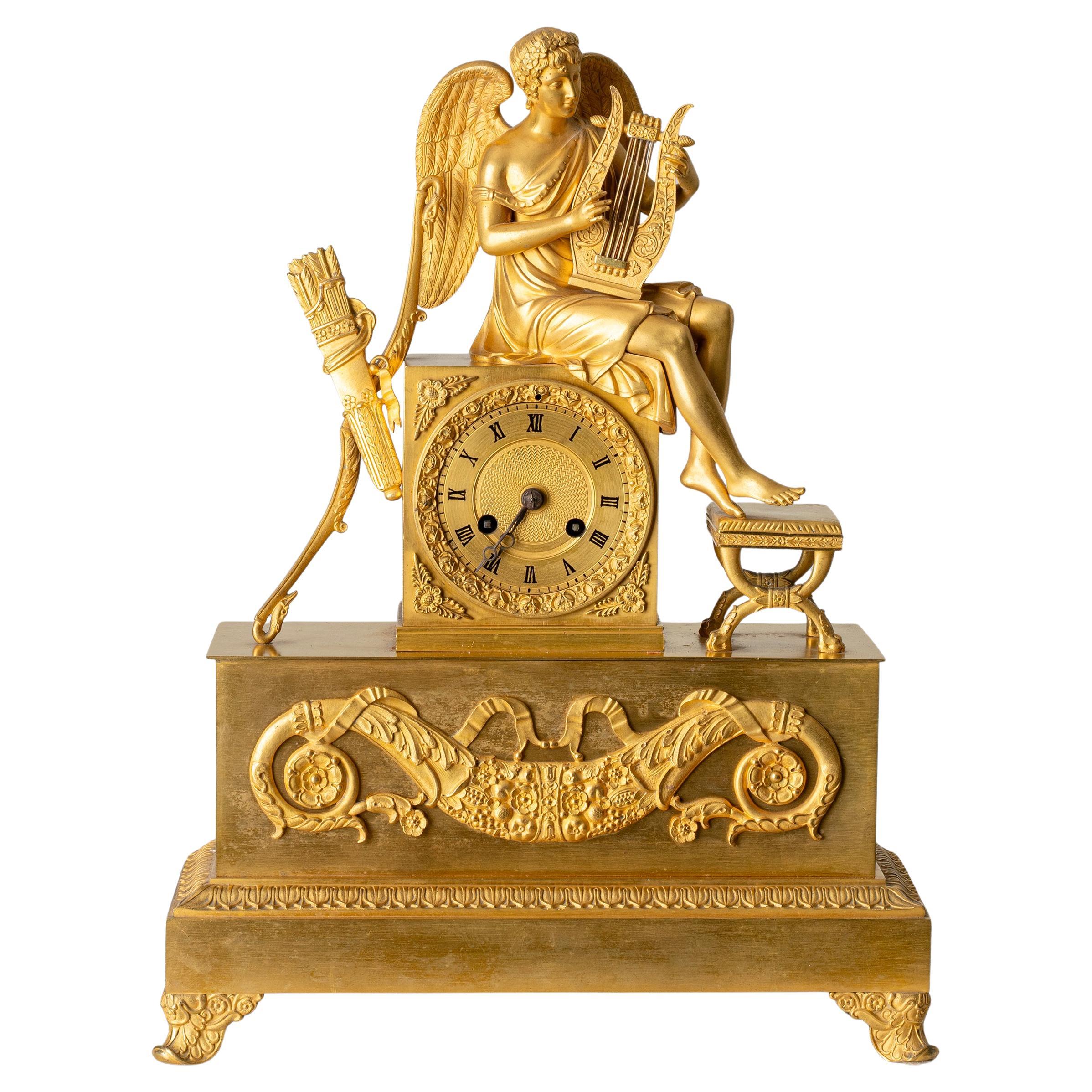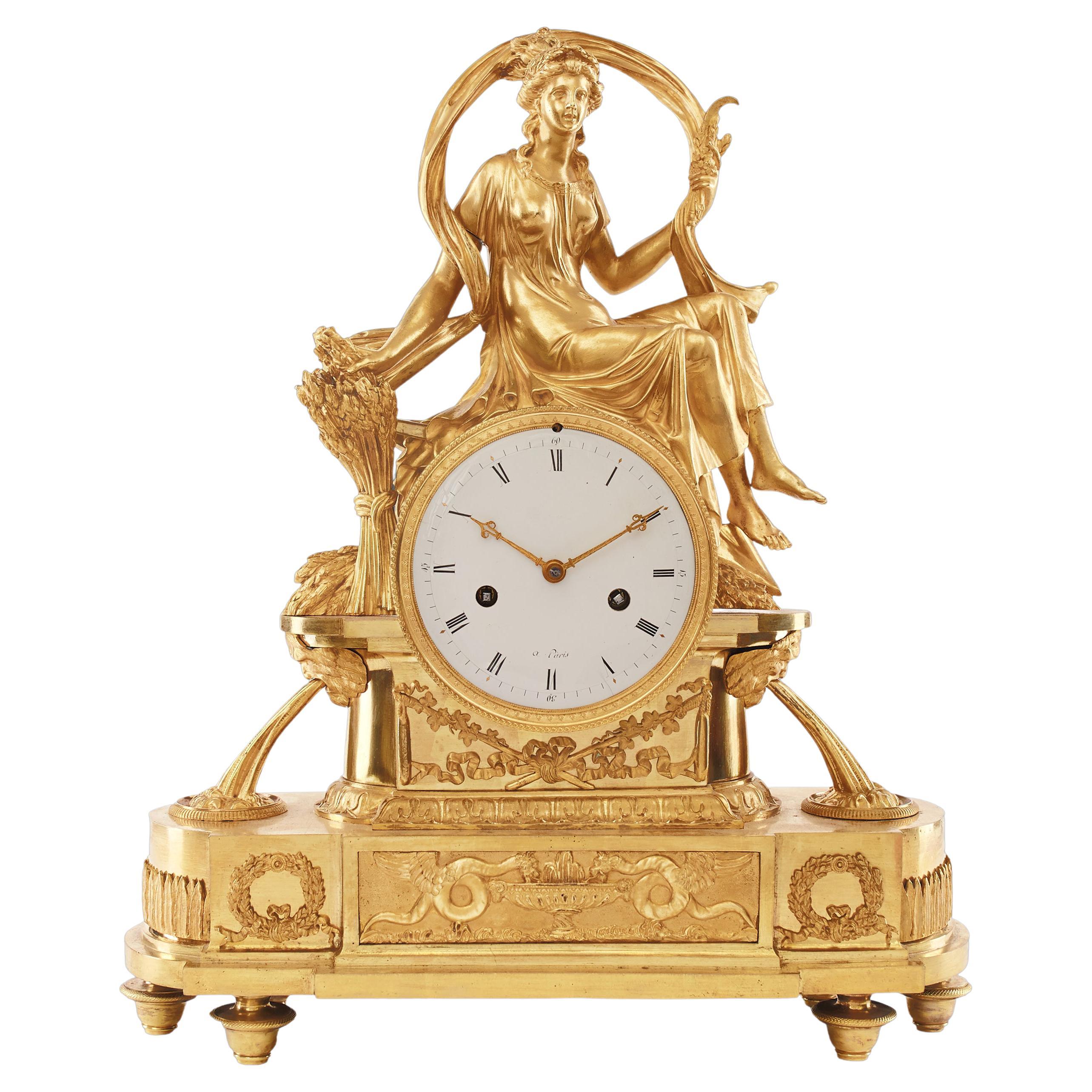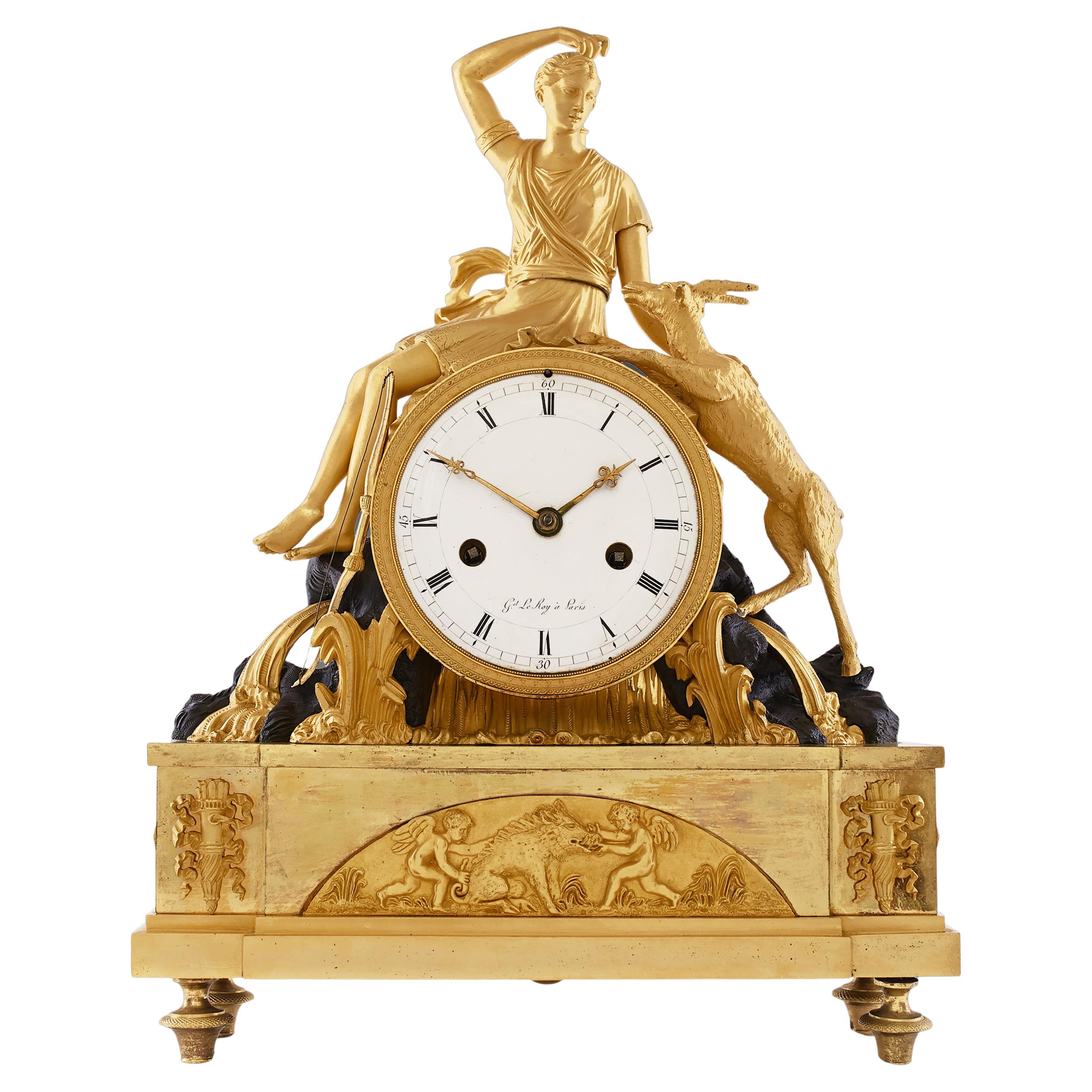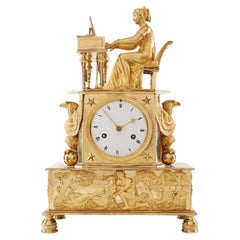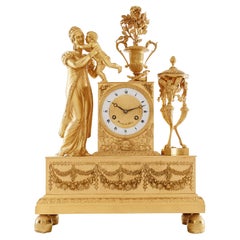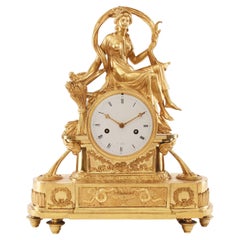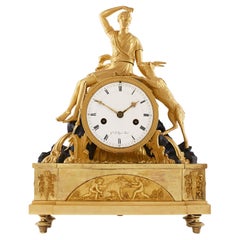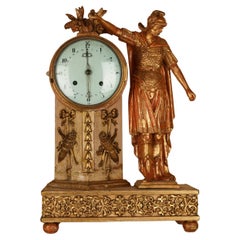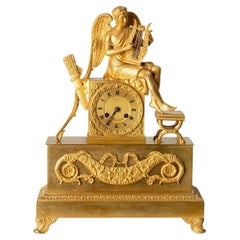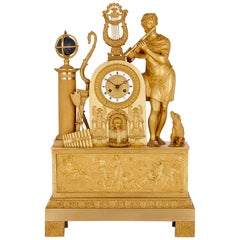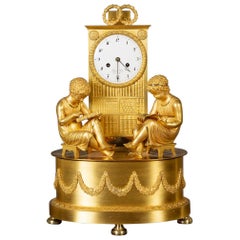Items Similar to Mantel Clock 19th Century Empire
Want more images or videos?
Request additional images or videos from the seller
1 of 9
Mantel Clock 19th Century Empire
$4,494.92
£3,330.06
€3,770
CA$6,157.81
A$6,832.61
CHF 3,579.07
MX$83,786.12
NOK 45,524.50
SEK 42,973.19
DKK 28,677.56
Shipping
Retrieving quote...The 1stDibs Promise:
Authenticity Guarantee,
Money-Back Guarantee,
24-Hour Cancellation
About the Item
Figural mantel clock signed “Al. dre Destape Palais Royal”
The bronze figural mantel clock depicting one of the mythical heroes - Orpheus originates from the Empire period. The clock is made in a characteristic Empire style, a major phase of Neoclassical art that flourished in France during the time of the First Empire in the 19th century. Bronze was the main material used in Empire style timepieces and both the patina and ormolu techniques were vastly used for ornamentation during this period. The use of gilt-bronze has reached its peak at the beginning of the 19th century in France, as it was cheaper than gold or silver. For this reason, it became the favourite material for clock cases, ornamental elements, candelabra and furniture ornaments. Owing to the skill of remarkable bronze casters and chasers these objects were not merely timekeepers but became objets d'art. Many of the characters and scenes inspired by Greco-Roman antiquity presented on the Louis XVI style clocks made appearances on the clocks produced in the first quarter of the nineteenth century. However, the style was completely changed and the clocks were more amiable.
This beautiful ormolu bronze mantel clock is surmounted by a bronze sculpture of Orpheus, and according to some Greek myths, was the son of Apollo and the muse Calliope, who also was endowed with extraordinary musical skills. The figure of Orpheus on the clock is modelled with a gold lyre in his hands that is known to be a gift from the god Apollo. Moreover, the lyre became Orpheus symbol because of his adventures and the contributions it had in them. He was the first one to perfect the skill of playing the lyre, as a result, his music could charm animals, trees, beasts, divert the course of rivers or even convince gods to change their will. The most popular myth featuring Orpheus was about his journey to the Underworld to retrieve his deceased wife, which he loved tremendously. Unfortunately, the story ended tragically and he never retrieved his wife back. His motivation and power of love became his main traits.
Many elements featured on this mantel clock represents Orpheus and his extraordinary skills at playing instruments. The lyre which Orpheus is holding stands on the gilded bronze clock case next to a floral wreath with a burning torch inside it. On the opposite side of the clock case, is a gilded bronze bouzouki with a matching foliage motif to the lyre.
Besides the figure of Orpheus, the second main feature of this clock are the reliefs that adorn the clock case as well as the rectangular plinth.
The case of the clock is build of a large ormolu bronze pedestal. The enamel dial is encircled by Roman numerals for hours and minutes. To indicate the time the clock uses blue Breguet-style hands, which have a circle with a filled crescent shape on the side. This unique shape is sometimes referred to by the French word for apple, pomme. The dial is also signed “Al. dre Destape Palais Royal” at the bottom. Surrounding the dial are beautiful rose reliefs, and beneath them is relief with a burning torch accompanied by foliage garland and wreath. The pedestal clock case is framed at the bottom with a rais-de-cœur motif, that also features at the bottom of the base trim.
The plinth is also decorated with reliefs, however, they are separated into three medallions. The two medallions which are situated on the left and right side depicts a rose wreath encircling two crossed arrows with an undulating ribbon tied to them. The medallion in middle shows a dragonfly, goose, laurel leaf branches with berries and ancient Greek musical instruments, all representing Orpheus ability to charm with his music.
The ormolu clock stands on the chiselled and gilded bronze ball feet.
Literature
An identical model of this clock can be found in the Pierre Kjellberg, "La Pendule Française du Moyen Age au XXe Siècle", 1997, p. 405, pl. D with minor differences, which is the lack of a burning torch in a floral wreath.
- Dimensions:Height: 21.26 in (54 cm)Width: 13.39 in (34 cm)Depth: 5.12 in (13 cm)
- Style:Empire (Of the Period)
- Materials and Techniques:
- Place of Origin:
- Period:
- Date of Manufacture:1820-1830
- Condition:Rewired: The clock is in a excellent and perfect working condition. Also it has recently been cleaned and serviced by a professional clock maker.
- Seller Location:Warsaw, PL
- Reference Number:1stDibs: LU5826227424212
About the Seller
5.0
Vetted Professional Seller
Every seller passes strict standards for authenticity and reliability
Established in 2021
1stDibs seller since 2021
33 sales on 1stDibs
Typical response time: 15 hours
- ShippingRetrieving quote...Shipping from: Warsaw, Poland
- Return Policy
Authenticity Guarantee
In the unlikely event there’s an issue with an item’s authenticity, contact us within 1 year for a full refund. DetailsMoney-Back Guarantee
If your item is not as described, is damaged in transit, or does not arrive, contact us within 7 days for a full refund. Details24-Hour Cancellation
You have a 24-hour grace period in which to reconsider your purchase, with no questions asked.Vetted Professional Sellers
Our world-class sellers must adhere to strict standards for service and quality, maintaining the integrity of our listings.Price-Match Guarantee
If you find that a seller listed the same item for a lower price elsewhere, we’ll match it.Trusted Global Delivery
Our best-in-class carrier network provides specialized shipping options worldwide, including custom delivery.More From This Seller
View AllMantel Clock 19th Century Styl Empire
Located in Warsaw, PL
This nineteenth-century gilded bronze clock exemplifies the grandeur of the Empire style, featuring a rectangular base with four legs, each intricately carved with subtle patterns. A...
Category
Antique Early 19th Century French Empire Mantel Clocks
Materials
Bronze
Mantel Clock 19th Century Styl Empire by Bonieris À Paris
Located in Warsaw, PL
This elegant mantel clock is a true collector's piece. It features a beautifully sculpted gilt bronze case adorned with delicate details, including floral garlands and putti.
The cen...
Category
Antique Early 19th Century French Mantel Clocks
Materials
Bronze
Mantel Clock 19th Century Styl Empire by Cérés À Paris
Located in Warsaw, PL
Empire clock signed à Paris
The mantel clock is in gilded bronze representing Ceres as a goddess of fertility, agriculture, grain crops and motherly relationships. In ancient Rom...
Category
Antique Early 19th Century French Empire Mantel Clocks
Materials
Bronze
Mantel Clock 19th Century Styl Empire by Leroy à Paris
Located in Warsaw, PL
A magnificent 19th-century Empire-style mantel clock, signed by the esteemed clockmaker Leroy à Paris. This timepiece exudes classical elegance, featuring a finely detailed gilt bron...
Category
Antique Early 19th Century French Empire Mantel Clocks
Materials
Bronze
Mantel Clock 19th Century Styl Empire by Galle, Rue Vivienne À Paris
Located in Warsaw, PL
This is a beautiful antique French Empire mantle clock was made of gilded bronze and marble. The clock is placed on a rectangular marble pedestal...
Category
Antique Early 19th Century French Empire Mantel Clocks
Materials
Marble, Bronze
Mantel Clock 19th Century Louis Philippe Charles X Period
Located in Warsaw, PL
Empire pendulum clock
Depicting Virgil,an ancient Roman poet of the Augustan period.He has been traditionally ranked as one of Rome's greatest po...
Category
Antique Early 19th Century French Louis Philippe Mantel Clocks
Materials
Malachite, Bronze
You May Also Like
19th Century Empire Mantel Clock
Located in Ljungby, SE
An Empire mantel clock in gilded wood, made in Austria or Germany 1820-1830. It features a warrior dressed in classical armor with his arm resting atop the clock. The clock pillar is...
Category
Antique 19th Century European Empire Mantel Clocks
Materials
Wood
Table Clock Empire Period France
Located in New York, NY
A mantel clock made during the Empire period 1790-1820 in France. Made from burnished gilt bronze. The Greek God Apollo is playing the lyre with his feet resting on a guilded stool.
Category
Antique 1790s French Empire Table Clocks and Desk Clocks
Materials
Bronze
Empire Period Gilt Bronze Mantel Clock
Located in London, GB
This truly stunning French mantel clock was crafted during the Empire period, and reflects the Neoclassical interests of the Emperor Napoleon I, whose influence over the decorative arts contributed toward a profound revival of beauties of the ancient empires.
The mantel clock is crafted entirely in gilt bronze, and features a stepped base on four block feet. The base depicts a Classical relief panel to the front, showing female dancing figures and putti, as well as musical instruments. Surmounting the base is an arch featuring a central mask fountain and basin...
Category
Antique Early 19th Century French Empire Mantel Clocks
Materials
Ormolu, Bronze
French Empire Ormolu Mantel Clock
Located in Norwich, GB
French Empire Ormolu mantel clock resting on four turned feet supporting an oval base with raised garland and zig-zag rope decoration...
Category
Antique Early 1800s French Empire Mantel Clocks
Materials
Ormolu
19th Century French Empire Clock
Located in Los Angeles, CA
19th Century finely chased and cast dore bronze mantle clock. Porcelain dial in excellent condition. Signed "Millet." Original pendulum. Don't have original key, but can have one made.
Category
Antique 19th Century French Empire Mantel Clocks
Materials
Marble, Bronze
Mantel Clock with Apollo, Early 19th Century
Located in Greding, DE
Large fire-gilded bronze pendulum clock on lion's paws with a rectangular pedestal featuring lyre and torch motifs. Above it rises the full-figure depiction of the god Apollo with a ...
Category
Antique Early 19th Century French Neoclassical Mantel Clocks
Materials
Bronze
More Ways To Browse
Roman Numeral Clock
Second Empire Furniture
French First Empire Furniture
Gold Clock Blue
Art D Clock
Antique Empire Clock
French Second Empire
Blue Enamel Clock
Gilded Bronze Clocks
French Empire Clock
Antique Clock Stand
Empire Bronze Clock
Mantel Candelabra
French Empire Mantel Clock
Gilded Bronze Mantel Clock
French Clock With Sculpture
Antique French Sculpture Clock
French Empire Gilt Bronze Clock
